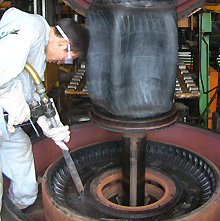
So, you just changed your motorcycle tires with a new pair and felt the first ride slippery. You started thinking why are new motorcycle tires slippery? Is it the newness, material, or brand of tires that make them slippery?
The slippery appearance of tires is not new. As a matter of fact, almost all new motorcycle tires come with a glossy appearance. Does that mean you need to worry if the tires are slippery?
Is it okay to ride a motorcycle at high speeds with slippery tires? What are the measures to adopt after changing tires to avoid slipping on the road?
These are some of the questions you will find answers to in this post. We will also look at how to reduce the slippery phase of motorcycle tires after installation. So, keep reading!
Why are new motorcycle tires slippery?
New motorcycle tires are slippery because of the curing process they go through in the final stages of manufacturing. The slippery appearance is subject to the release agent/chemical used to complete the curing process.
Secondly, the rubber compound used in new tires is softer than the old ones which lack complete grip making it slippery.
Brand-new tires often comprise shallower tread patterns because of their non-usage. This again impacts the grip of new tires making them slippery, especially on slick surfaces.
The slippery phase also depends on the brand and type of new tires. Many tire manufacturing companies have adopted modern techniques to mold the tires that eliminate the need to add release agents/chemicals during the curing process.
Does that mean you need to worry or take caution while riding the motorcycle on new tires? Before answering this question let’s understand…
The curing process
The curing process is meant to bond all the compounds and materials of tires together. This process is executed in the final stages where the whole tire is put into a mold.
The mold is used to cure the tire under high temperatures and pressure to get the desired shape.
Under the curing process, the inner liner, sidewall, and tread of tires are strongly bonded with the rubber material and then vulcanized to join all these components together to create a more durable and flexible product.

Once the process is completed, the tire needs to be released from the mold which is done using a release agent. This release agent forms the part of the tire’s slippery surface if not completely removed by the manufacturer.
The curing process is still a vital part used to manufacture tires but some reputed tire manufacturers have found innovative ways with respect to the usage of release agents/chemicals.
The Teflon molding process is one such innovation where no release agent is required to remove the tires from the mold. Without the release agent, tires appear from the mold with a rough surface under the Teflon process against the shiny/slippery surface that is common under the normal molding process.
So, if you have new tires from a brand or company that uses Teflon or any such process for molding then no need to worry, about the impacts of slippery surfaces.
However, if you have installed brand new tires that are glossy or shiny and feel slippery then follow the below precautionary measures for better grip and controlled ride.
Take it easy
A brand-new tire with a slippery surface can cause accidents. Riders with less information on the usage of new tires continue with the same approach while riding as it was with the old tires.
Overspeeding, acceleration, sudden braking, and sharp cornering are some aspects that should be performed with caution. The idea is to take it easy before the new tires get a better grip and traction with more usage.
Avoid speeding
Slow riding is the best way to let the new tires adapt to the surface. Avoid speeding or accelerating too fast suddenly. This may skid the tires owing to the slippery material.
People who have experienced the atrocities of riding on new tires follow the approach of riding a motorcycle in wet conditions (rainfall). Slow and steady throttling, soft braking, and less amount of flicking are some of the precautions.
Related Read: Why does a motorcycle blow white smoke?
Having said this, try to avoid wet or slick conditions as much as possible till the tires find better contact and grip with the road.
Let the new tires scrub
Now scrubbing does not mean taking sandpaper and rubbing the tire to remove the shine/slippery surface. If you are too paranoid you can do that.
However, the best way to keep scrubbing the new tires is by letting them touch the road. The more sections/parts of the tire get contracted with the road, the higher scrubbing you will achieve.
Keep leaning
While following the slow approach for a few kilometers motorcyclists tend to believe that 100% scrubbing is achieved. This is not the case, especially on the cornering edges of tires.
Precautionary usage is helpful in scrubbing the tires to the extent of the middle surface. Since the edges are still new and slippery the tires won’t meet the gripping potential.
This is where you should continue leaning and put some force while cornering or turning to let those untouched edges get scrubbed.

Progressive leaning is required to remove the slippery patches and achieve 100% scrubbing on all the parts of a tire. When you do this, the tires will lose the slippery effect and attain better grip, control, and traction.
How long should you run to get proper scrubbing of new tires?
If you follow all the tips mentioned above a 2-mile ride could be enough. However, some riders consider following a thumb rule of utilizing a full tank of gas or at least 100 miles.
In my personal opinion, removing the slickness or slippery surface of new tires is fruitful when you hit the lean angle correctly on all sides.
Start with slow speed and gradually increase the lean angle and force by covering the sides and edges of the tires.
The best way to do this is by circling a few miles in the ground or a parking lot with lots of empty space. Once you notice that the tires have found roughness and lost slickness on all the sides it is good enough to ride at normal speed.
Final thoughts
Riding a motorcycle with slippery tires could be dangerous. With some brands and tires, you don’t have to worry about the dangers of slipping.
The problem arises when you see glossy shine, slickness, and slippery surface on new tires.
The main reason for the slippery surface is the curing process a tire goes through. You cannot avoid the process however you can follow the precautions and tips provided in this post to make the new tires safer while riding.
As a matter of fact, you must always avoid overspeeding, keep your motorcycle tires properly inflated and beware of your surroundings for a safe, secure, and enjoyable ride.
Follow the precautions to the core with more vigilance and extra caution when you are riding on new tires.

